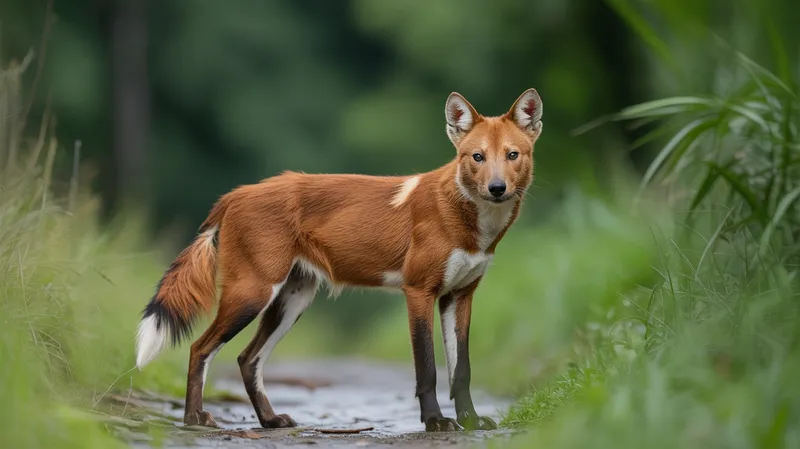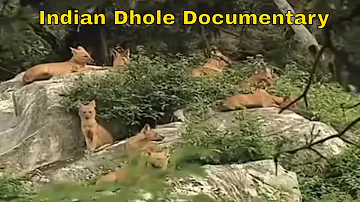
Dhole
Cuon alpinus

Meet the Dhole
The dhole, also known as the Asiatic wild dog, is a highly social and intelligent canid native to Central, South, and Southeast Asia. Distinguished by its reddish coat, bushy black-tipped tail, and lean build, the dhole is an agile hunter that lives and hunts in packs, often taking down prey much larger than itself. Unlike other wild canids, dholes are known for their unique whistling communication calls and cooperative pack behavior. Their populations are declining due to habitat loss, disease, and competition with other predators.
Classification
Mammal
Habitat
Forests, grasslands, and mountainous regions
Diet
Carnivore
Lifespan
10-14 years
Conservation
Endangered
Weight
10-21 kg
📖Fascinating Facts
Pack Hunters
Dholes hunt cooperatively in packs of 5 to 12 members, allowing them to bring down prey much larger than themselves, such as deer and wild boar.
Habitat Versatility
They inhabit a wide variety of ecosystems, including tropical forests, grasslands, alpine meadows, and mountainous regions up to 4,000 meters.
Whistling Calls
Dholes are known for their distinctive whistling calls, which they use to communicate with pack members and coordinate during hunts.
📋Detailed Description
The dhole (Cuon alpinus) is a medium-sized canid, with adults typically weighing between 10 and 21 kg and measuring 90 to 135 cm in body length, with a bushy tail of 40 to 50 cm. Its dense, short coat is usually reddish-rust on the back and flanks, with paler underparts and a distinctive black-tipped tail. Anatomically, dholes are distinguished from other canids by a convex skull profile, a shortened rostrum, and unique dental features: they lack the third lower molar and have upper molars with a single cusp, adaptations for a hypercarnivorous diet. Dholes are highly social, living in cohesive packs of 5 to 12 individuals, though larger groups of up to 40 have been recorded. Their social structure is complex, with a dominant breeding pair and cooperative care of young. Dholes are diurnal, relying on coordinated group hunting to capture prey such as deer, wild boar, and occasionally livestock. They are renowned for their vocalizations, including unique whistles, chatters, and screams used for communication and coordination. Agile and fast, dholes are capable of long-distance chases and can leap up to 2 meters high. Their ecological role as apex predators is vital for regulating prey populations and maintaining ecosystem balance.
💡 Did you know?
Dholes lack a third lower molar, a unique dental feature that distinguishes them from other wild dogs and wolves.
🔬Research & Sources
Wikipedia Summary
The dhole is a canid native to South, East and Southeast Asia. It is anatomically distinguished from members of the genus Canis in several aspects: its skull is convex rather than concave in profile, it lacks a third lower molar, and the upper molars possess only a single cusp as opposed to between two and four. During the Pleistocene, the dhole ranged throughout Asia, with its range also extending into Europe but became restricted to its historical range 12,000–18,000 years ago. It is now extinct in Central Asia, parts of Southeast Asia, and possibly the Korean peninsula and Russia.
Last Modified: 5/23/2025
🎭Behavior & Social Structure
Dholes exhibit highly cooperative social and hunting behaviors. Packs operate with a clear hierarchy, often led by an alpha pair, and display strong social bonds through grooming, play, and communal care of pups. Hunting is typically a group activity, with dholes employing endurance running and strategic encirclement to exhaust and bring down prey, often much larger than themselves. They are known to dismember prey rapidly, allowing all pack members, including pups, to feed simultaneously. Unlike many canids, dholes rarely cache food. Communication is sophisticated, involving a repertoire of vocalizations—most notably high-pitched whistles that can carry over long distances, facilitating pack cohesion in dense forests. Dholes are primarily diurnal, with peak activity in the early morning and late afternoon. Territorial, they mark boundaries with scent and vocal displays, but direct aggression between neighboring packs is rare.
👶Reproduction & Life Cycle
Dholes are seasonal breeders, with mating typically occurring between November and March, depending on geographic location. The dominant female is usually the sole breeder, though subordinate females may occasionally breed. After a gestation period of 60 to 63 days, the female gives birth to a litter of 4 to 10 pups in a den, often located in abandoned burrows or rocky crevices. All pack members participate in pup rearing, providing food through regurgitation and guarding the den. Pups are weaned at about 2 months but remain dependent on the pack for food and protection for several more months. Sexual maturity is reached at around one year, but young dholes may remain with their natal pack for several years before dispersing.
🛡️Adaptations & Survival
Dholes possess several adaptations for their predatory and social lifestyle. Their slender, muscular bodies and long limbs enable speed and agility, essential for pursuing prey in varied terrain. The reduction in molar number and the development of a single-cusped upper molar are specialized for shearing flesh, reflecting a diet heavily reliant on meat. Their complex vocalizations, including the signature whistle, are uniquely adapted for communication in dense habitats where visual contact is limited. Social cooperation in hunting and pup-rearing increases survival rates and hunting efficiency. Dholes are also capable swimmers and can traverse rivers and streams, expanding their hunting range. Their high reproductive potential and flexible social structure allow rapid recovery from population declines under favorable conditions.
📚Research Sources
🎨Cultural Significance
The dhole features in the folklore and mythology of several Asian cultures, often depicted as clever, elusive, or even supernatural creatures. In India, it is sometimes called 'the whistling hunter' due to its distinctive calls. While not as prominent as the wolf or tiger in cultural narratives, dholes have been both respected and feared by local communities for their hunting prowess. There is little evidence of traditional use for fur or body parts, but negative perceptions persist due to livestock predation, leading to conflict with pastoralists. Conservation outreach increasingly emphasizes the dhole’s ecological importance and unique biology to foster coexistence.
🔬Recent Research & Discoveries
Recent genetic studies have clarified the dhole's evolutionary history, confirming its divergence from Canis over 5 million years ago and its status as the sole extant member of the genus Cuon. Ongoing research focuses on population genetics, disease ecology, and the impacts of habitat fragmentation. Camera trap and radio-collar studies have provided new insights into dhole movement patterns, territory size (ranging from 23 to 90 km²), and prey preferences. Conservationists are also investigating the role of dholes in ecosystem health and their interactions with sympatric predators such as tigers and leopards. Notably, studies highlight the dhole’s sensitivity to human disturbance and the importance of landscape connectivity for long-term survival.
🎥Wildlife Videos

Dhole Wild Dog Documentary
I created this video with the YouTube Video Editor (http://www.youtube.com/editor)
Epic Documentaries

Dhole: The Phantom Of The Forest - Wildlife Documentary
The dhole is a canid native to Central, South and Southeast Asia. Other English names for the species include Asiatic wild dog, ...
Nature Documentaries TV

WildLife Sanctuary - Indian wild dogs (Dhole) Full Documentary - Animals In Asia
Gay lifestyle, gay health, gay travel by Love Men To Men!!! Read more in here!!! https://lovementomen.blogspot.com Check out my ...
Channel Synthetic Films

Dholes Are The Bane Of Tigers Everywhere
----------- SOCIAL MEDIA https://www.tiktok.com/@animalogic https://www.instagram.com/animalogicshow/ ...
Animalogic

Dhole Pack Coordinates Attack on Deer
To survive in the forests of southern India, dholes must work together. Please LIKE and SUBSCRIBE if you enjoyed it!
Nature on PBS

“The Dhole: Asia’s Forgotten Wild Dog”
Discover the Secrets of the Dhole—Asia's Forgotten Wild Dog Join us as we delve into the world of the dhole (Cuon alpinus), ...
Rewilding the future
🌍Habitat Information
The Dhole typically inhabits Forests, grasslands, and mountainous regions environments. Dholes have adapted to their environments with specialized features and behaviors.
Primary Habitat:
Forests, grasslands, and mountainous regions
More detailed habitat information will be available soon.
🛡️Conservation Status
The Dhole is currently classified as Endangered. Conservation efforts are crucial for preserving this species for future generations.
Common Threats:
- 🏠Habitat loss and fragmentation
- 🌡️Climate change impacts
- 🎯Hunting and poaching
- 🏭Human-wildlife conflict
⚠️Threats & Conservation Challenges
Dhole populations have declined sharply due to habitat loss and fragmentation, depletion of prey species from overhunting and competition with humans, and direct persecution (including poisoning and shooting) in retaliation for livestock predation. Infectious diseases, particularly canine distemper and rabies transmitted from domestic dogs, pose significant threats. Fragmented populations are increasingly isolated, leading to reduced genetic diversity and increased vulnerability. The current global population is estimated at fewer than 2,500 mature individuals, with continuing declines observed throughout their range. Conservation challenges include enforcing protected area boundaries, restoring prey populations, mitigating human-wildlife conflict, and controlling disease transmission from domestic animals.
🔬Scientific Classification
Scientific Name
Cuon alpinus
Classification Hierarchy
🔍 About Taxonomic Classification
Taxonomic classification is a hierarchical system used by scientists to classify and organize living organisms based on shared characteristics and evolutionary relationships.
The system moves from broad categories (Kingdom) to increasingly specific ones, with each animal's scientific name typically consisting of its Genus and species.
📝Community Notes
Share your observations and insights about the Dhole with our community of wildlife enthusiasts.
Join Our Community
Sign in to share your observations and connect with fellow wildlife enthusiasts.
Sign In to ContributeNo community notes yet
Be the first to share your observations about the Dhole!
Explore Dhole
Select a tab above to learn more about this amazing animal.
📸Photo Gallery
No photos available for this animal yet.
🌟Discover More Wildlife
Continue your journey of discovery with more fascinating animals from our database
